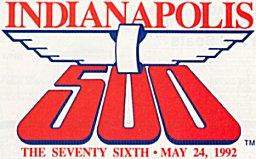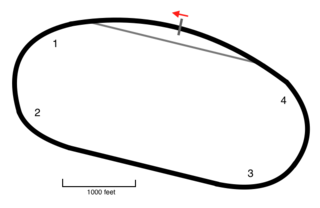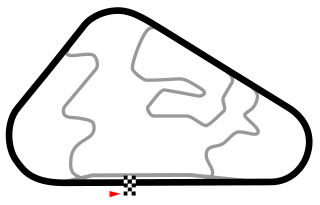The Greatest 33 is a list of top drivers from the history of the Indianapolis 500. In 2011, in celebration of the 100th anniversary of the first Indianapolis 500, the Indianapolis Motor Speedway gathered a panel of media and historians to establish 100 nominees for the best drivers who have participated in the Indianapolis 500 from 1911 to 2010. [1] During the months leading up the race, fans were invited to vote on the best 33 among the nominees, [1] [2] and the finalists were announced in the days leading up to the 2011 race. [1]
The selection of 33 drivers reflects the traditional 33 starters that comprise the field for the Indianapolis 500 annually.
Of the 732 drivers [1] who had participated in the Indianapolis 500 from 1911 to 2010, a list of 100 nominees was narrowed down by a panel of experts. The criteria were somewhat loose, as winning the race was not necessarily a requirement for inclusion. At the time, only 68 drivers had won the race, and of those, only 57 were nominated. Other factors that were weighed included: pole position winners, lap leaders, rookies of the year, individual statistical accomplishments, accomplishments of a historical nature, and popular fixtures.
The original list of 100 drivers was released on March 18, and voting continued through May 14. [3]
The final list of 33 drivers was announced May 15. The three four-time Indy 500 winners A. J. Foyt, Al Unser Sr., and Rick Mears comprised the front row. [1] The three most recent three-time winners Bobby Unser, Johnny Rutherford, and Hélio Castroneves, made up the second row. [1] Three non-winners, Tony Bettenhausen Sr., Dan Gurney, and Michael Andretti, [1] were selected, although Gurney and Andretti are former race-winning owners, and both had second-place finishes in their careers. Ray Harroun, winner of the inaugural race was situated in row nine, alongside Tommy Milton, the first-ever two-time winner.
All 17 of the multiple Indy 500 winners going into the 2011 race were included on the list. [1] Of the thirty-three finalists, twenty-one were living at the time the list was released. Only four drivers (Castroneves, Franchitti, Dixon, and Montoya) on the list were considered active in professional-level motorsports at the time.
Immediately after the list was released, critical reaction was both positive and negative. [2] [4] [5] There was almost universal acclaim for the three four-time winners being on the front row (Foyt, Unser, Mears). [1] However, there was considerable dissent regarding winners that were not included, bias towards recent years, [1] and the inclusion of non-winners. [1] Due to the limitations of the final list size (33 names), it was not possible for all 68 former winners to be included. Also, significant non-winners such as Rex Mays and Ted Horn were not included in the final grid. [1]
There were several dissents early on among fans and media regarding drivers included on the original list of 100 finalists, such as Danica Patrick and Marco Andretti. However, none of the highly controversial nominees made the final official list. Dan Wheldon (who at the time of voting had won only once) won the race for the second time just days after the list was released. Along with four other top-4 career finishes, and three front row starts, considerable speculation afterwards suggested Wheldon would have made easily the list had the voting been conducted after the race.
After the official announcement, merchandise including T-shirts and other collectibles, were marketed in The Greatest 33 theme.
The top three vote-getters consisted of the three four-time Indianapolis 500 winners.

Robert William Unser was an American automobile racer. At his induction into the Motorsports Hall of Fame of America in 1994, he had the fourth most IndyCar Series wins at 35. Unser won the 1968 and 1974 United States Automobile Club (USAC) national championships. He won the Pikes Peak International Hill Climb overall title 10 times.
As of 107th race, May 28, 2023.

The 2003 IRL IndyCar Series brought some of the biggest changes in its history. The league adopted the name IndyCar Series, after a settlement with CART prohibiting its use had expired. Several former CART teams brought their full operations to the IRL, most notably major squads Chip Ganassi Racing and Andretti Green Racing, as well as former CART engine manufacturers Toyota and Honda, replacing Infiniti who shifted its efforts to the new feeder series Infiniti Pro Series. Many of the IRL's old guard including Robbie Buhl, Greg Ray, and Buddy Lazier had difficulty competing in this new manufacturer-driven landscape. The league also added its first international race this year, taking over the CART date at Twin Ring Motegi.

The 62nd 500 Mile International Sweepstakes was held at the Indianapolis Motor Speedway in Speedway, Indiana on Sunday, May 28, 1978. Danny Ongais dominated the early stages of the race but eventually dropped out with a blown engine. Al Unser Sr. dominated the second half, and held a large lead late in the race. However, Unser bent the front wing of his Lola during a pit stop on lap 180, causing his handling to go away over the final twenty laps. Second place Tom Sneva charged to catch Unser's crippled Lola but came up 8 seconds short at the finish line – the second-closest finish in Indy history to that point. Unser held off the challenge, and became a three-time winner of the 500. It was Al Unser's third Indy victory in the decade of the 1970s, and the fifth of nine overall victories by the Unser family.

The 64th 500 Mile International Sweepstakes was held at the Indianapolis Motor Speedway in Speedway, Indiana on Sunday, May 25, 1980. Johnny Rutherford won the pole position, led 118 laps, and won the race by a commanding 29.92 second margin. After failing to finish the race the year before, Jim Hall's radical new Chaparral 2K ground effects chassis was a heavy favorite entering the month, and drove a flawless race. Rutherford, the winner in 1974 and 1976, became the sixth driver to win the Indy 500 three times.

The 65th Indianapolis 500 was held at the Indianapolis Motor Speedway in Speedway, Indiana, on Sunday, May 24, 1981. The race is widely considered one of the most controversial races in Indy history. Bobby Unser took the checkered flag as the winner, with Mario Andretti finishing second. After the conclusion of the race, USAC officials ruled that Unser had passed cars illegally while exiting the pit area during a caution on lap 149. Unser was subsequently issued a one-position penalty. The next morning, the official race results were posted, and Unser was dropped to second place. Mario Andretti was elevated to first place and declared the race winner.

The 66th Indianapolis 500 was held at the Indianapolis Motor Speedway in Speedway, Indiana on Sunday, May 30, 1982. Gordon Johncock, who had previously won the rain-shortened 1973 race, was the winner. Polesitter Rick Mears finished second by a margin of 0.16 seconds, the closest finish in Indy 500 history to that point.

The 87th Indianapolis 500 was held at the Indianapolis Motor Speedway in Speedway, Indiana on Sunday, May 25, 2003. Two-time defending champion Hélio Castroneves won the pole position and was trying to become the first driver in Indy history to win three in a row. With 31 laps to go, however, Castroneves was passed by his Penske teammate Gil de Ferran, and the duo finished 1st–2nd, with de Ferran winning his first Indy 500. The race was sanctioned by the Indy Racing League and was part of the 2003 IndyCar Series season.

The 76th Indianapolis 500 was held at the Indianapolis Motor Speedway in Speedway, Indiana, on Sunday, May 24, 1992. The race is famous for the fierce battle in the closing laps, as race winner Al Unser Jr. held off second place Scott Goodyear for the victory by 0.043 seconds, the closest finish in Indy history. Unser Jr. became the first second-generation driver to win the Indy 500, following in the footsteps of his father Al Unser Sr. He also became the third member of the famous Unser family to win the race.

The 75th Indianapolis 500 was held at the Indianapolis Motor Speedway in Speedway, Indiana, on Sunday, May 26, 1991. Rick Mears won from the pole position, becoming the third four-time winner of the Indy 500, joining A. J. Foyt and Al Unser. During time trials, Mears also established an Indy record by winning his sixth career pole position. The month of May for Mears was tumultuous, as he suffered his first ever crash at Indy since arriving as a rookie in 1977. The wreck during a practice run totaled his primary car, and broke a bone in his right foot. Mears kept the injury mostly secret, and later admitted that the pain he experienced during the race was so bad, he had to cross his legs in the car and push the accelerator pedal down with his left foot.

The 72nd Indianapolis 500 was held at the Indianapolis Motor Speedway in Speedway, Indiana, on Sunday May 29, 1988. Team Penske dominated the month, sweeping the top three starting positions with Rick Mears winning the pole position, Danny Sullivan at the center of the front row, and Al Unser, Sr. on the outside. Mears set a new track record, becoming the first driver to break the 220 mph barrier in time trials. On race day, the Penske teammates proceeded to lead 192 of the 200 laps, with Rick Mears taking the checkered flag, his third-career Indy 500 victory. The race represented the milestone 50th victory in Championship car racing for owner Roger Penske and Penske Racing.

The 71st Indianapolis 500 was held at the Indianapolis Motor Speedway in Speedway, Indiana, on Sunday May 24, 1987. After dominating practice, qualifying, and most of the race, leader Mario Andretti slowed with mechanical problems with only 23 laps to go. Five laps later, Al Unser Sr. assumed the lead, and won his record-tying fourth Indianapolis 500 victory. During the month of May, an unusually high 25 crashes occurred during practice and qualifying, with one driver in particular, Jim Crawford, suffering serious leg injuries.

The 69th Indianapolis 500 was held at the Indianapolis Motor Speedway in Speedway, Indiana, on Sunday, May 26, 1985. The race was sanctioned by USAC, and was included as part of the 1985 CART PPG Indy Car World Series. The Speedway also celebrated 40 years of ownership by the Hulman/George family.

The 68th Indianapolis 500 was held at the Indianapolis Motor Speedway in Speedway, Indiana on Sunday May 27, 1984. Rick Mears, who previously won in 1979, won his second Indy 500 victories driving for Penske. Contenders Tom Sneva and Mario Andretti dropped out of the race in the second half, leaving Mears alone two laps ahead of the field, and he cruised to the victory. Three months after the race, however, Mears would suffer severe leg injuries in a practice crash at Sanair.

The Michigan 500 was an IndyCar Series race held at Michigan International Speedway in Brooklyn, Michigan. Held from 1981 to 2001, the event was held in high prestige, constituting part of Indy car racing's 500-mile "Triple Crown".

The Pocono 500 was an IndyCar Series race held at Pocono Raceway in Long Pond, Pennsylvania, located in the Pocono Mountains. The first Indy car race at Pocono was held in 1971. It was the first major event held at the track, shortly after its completion. The race was sanctioned by USAC from 1971 to 1981, and then by CART from 1982 to 1989, and was known as the Pocono 500. The race was removed from the CART calendar following the 1989 running, due to poor track conditions, as well as poor revenue for the promoter.

The 1980 CART PPG Indy Car World Series season was the second in the CART era of U.S. open-wheel racing. It consisted of twelve races, beginning in Ontario, California on April 13 and concluding in Avondale, Arizona on November 8. The PPG Indy Car World Series Drivers' Champion and Indianapolis 500 winner was Johnny Rutherford. Rookie of the Year was Dennis Firestone. The entire season, including the 64th Indianapolis 500, was to be co-sanctioned by both the USAC and CART under the banner of the Championship Racing League (CRL). However, USAC withdrew from the arrangement after five races.

The Indianapolis Motor Speedway Museum is an automotive museum on the grounds of the Indianapolis Motor Speedway in Speedway, Indiana, United States, which houses the Indianapolis Motor Speedway Hall of Fame. It is intrinsically linked to the Indianapolis 500 and Brickyard 400, but it also includes exhibits reflecting other forms of motorsports, passenger cars, and general automotive history. In 2006, it celebrated its 50th anniversary. The museum foundation possesses several former Indianapolis 500 winning cars, and pace cars, and they are regularly rotated onto the display floor exhibits.
The 1981–82 USAC Championship Car season consisted of six races, beginning in Speedway, Indiana, on May 24, 1981, and concluding at the same location on May 30, 1982. The USAC National Champion was George Snider. The season included two Indianapolis 500 races. The 1981 winner was Bobby Unser, while the 1982 winner was Gordon Johncock. The schedule included dirt courses for the first time since 1970.

The 95th Indianapolis 500 was held at the Indianapolis Motor Speedway in Speedway, Indiana on Sunday May 29, 2011. The race was part of the 2011 IZOD IndyCar Series season. The track opened for practice on May 14 and time trials were held from May 21 to 22. Alex Tagliani won the pole position, and the race was won by Dan Wheldon. It was his second Indy 500 win after the 2005 race, and the last win of his racing career. It was the first of two Indy victories for car owner Bryan Herta.